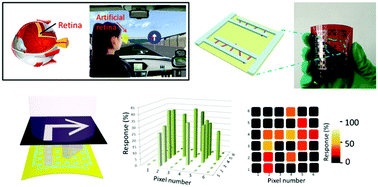A self-powered flexible vision electronic-skin for image recognition based on a pixel-addressable matrix of piezophototronic ZnO nanowire arrays
Abstract
The emerging electronic-skins (e-skins) are designed to mimic the comprehensive properties of human perception via flexible device techniques, and the achievement of a vision e-skin for image recognition is a highly interesting topic for applications in bionic organs and robots. In this paper, a new self-powered flexible vision e-skin has been realized from a pixel-addressable matrix of piezophototronic ZnO nanowire arrays. Under applied deformation, the e-skin can actively output piezoelectric voltage (piezoelectric effect), and the output piezoelectric voltage can be significantly influenced by UV illumination. The piezoelectric output can be regarded as both a photodetecting signal and electrical power for driving the device (no external power source is needed). The working mechanism is based on the optoelectronic/piezoelectric coupling effect (piezophototronic effect) of ZnO. The photo-generated carriers inside the ZnO nanowires can partially screen the piezoelectric field, affecting the piezoelectric output. The e-skin device has a 6 × 6 pixel-addressable matrix structure, and can map multi-point UV-stimuli through a multichannel data acquisition method, realizing image recognition. This new device structure and working mechanism may provoke a new research direction for the development of multi-functional e-skins.



 Please wait while we load your content...
Please wait while we load your content...